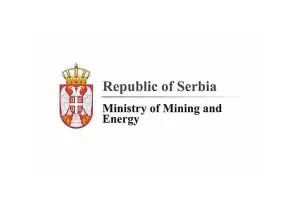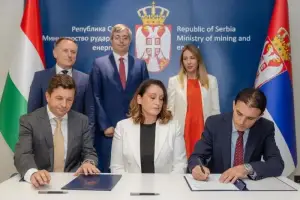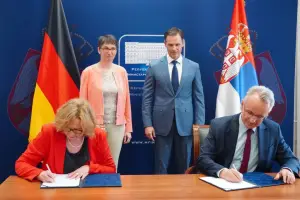Q:
A:
Foreign trade up January-July
Belgrade,
29 August 2008
The Serbian Statistics Office stated today that Serbia’s total foreign trade in the period from January to July this year amounted to $20,901.4 million, which was a 42.2% increase compared to the same period in 2007; or in Euros €13,583.7 million, which was a 23.4% increase compared to the same period in 2007.
The value of exports amounted to $6,747.9 million, which was a 40.3% increase when compared to the same period last year, while the value of imports amounted to $14,153.5 million, which was a 43.1% increase relative to the same period last year.
Expressed in Euros, the value of exports amounted to €4.383 million, which was an increase of 21.7%, compared to the same period last year. The value of imports amounted to €9,200.7 million, which was a 24.2% increase when compared to the same period last year.
The deficit stood at $7,405.6 million, which was an increase of 45.8% compared to the same period last year. The deficit expressed in Euros amounted to €4,817.7 million, which was an increase of 26.6% compared to the same period last year.
The export - import ratio equalled 47.7% and was lower when compared to the same period last year when it was 48.6%.
Increased imports in the previous period were a result of importing energy commodities the prices of which remain high on the world market and energy imports in the observed period amounted to 19.5 % of total imports; the import of copper and iron ores that are used for the production of basic and other metals and that presently have good prices on the world market. Increased demand also resulted in increased imports.
The increase in exports resulted from privatisation and company re-structuring to date, as well as the executed and ratified agreements on free trade with countries signatory to the Stability Pact, which are now integrated in the CEFTA agreement. Serbian exports to CEFTA agreement countries, for the reference period, amounted to $2,234 million and imports to $1,110 million. This surplus of $1,124 million is mainly the result of increasing exports of agricultural products. Increased exports are the result of the export of surplus agricultural products to other countries as well; the export of cereals and products thereof amounted to $174 million. Another factor was the executed agreement with the EU, as according to it, Serbian ready-made textile products have preferential status; therefore, there was also a surplus in the area of clothes exports. Other factors which contributed to the increase in imports were favourable conditions for the export of food, animal and vegetable oils and fats, products classified by materials and machinery and other transport equipment. One positive factor was also the market structure – Serbian exports refer mainly to the Euro zone market, while imported goods are mainly from the dollar area market. The increase in imports was also due to the rise in the value of the Serbian Dinar by 3% in relation to the Euro compared to the previous month.
In relation to the structure of exports according to products’ destination (the principle of prevalence), the most notable were: reproduction products 66.4% ($4,480.8 million), consumer goods 25.5% ($1,722.3 million) and equipment 8.1% ($544.6 million).
In relation to the structure of imports according to products’ destination, the most notable were: reproduction products 61% ($8,631.7 million), then consumer goods 21.9% ($3,101.6 million) and equipment 17.1% ($2,402.1 million).
The major foreign trade partners in exports in the reference period were: Montenegro ($816.8 million), Bosnia and Herzegovina ($789.8 million) and Italy ($751.0 million).
The major foreign trade partners in imports in the reference period were: the Russian Federation ($2,039.6 million), Germany ($1,756.4 million) and Italy ($1,388.9 million).
Foreign trade in the reference period was highest with the EU (more than 50% of total foreign trade).
A surplus was achieved in foreign trade with former Yugoslav Republics, Bosnia and Herzegovina, Montenegro and Macedonia. However, the greatest deficit was observed in trade with the Russian Federation, which was due to imports of energy commodities, mainly oil and gas and also due to our exporters’ insufficient application of the bilateral agreement on free trade.
According to the divisions of the Standard International Trade Classification the following items had the greatest share of exports: iron and steel ($994million), coloured metals ($462 million), clothes ($310million), metal products, ($284 million) and vegetables and fruits, ($267 million). These five sections accounted for 34.3% of overall exports.
The first five divisions with the greatest share of imports were the following: oil and oil derivatives ($1,646 million), road vehicles ($1,263 million), natural gas ($700 million), iron and steel ($717 million) and industrial machines for general use ($710 million) and these accounted for 35.6% of overall imports.
According to the Nomenclature of the External Trade Statistics the July list of the first 100 export products includes hot rolled products of various dimensions with a value of $69 million; machine parts ($27 million); hot rolled products of 4.75 mm thickness ($26 million), raspberries ($25 million); electricity ($22 million); rolled tin coated products ($21 million), new tires for passenger cars and scrap metal each worth ($16 million); million); floor coverings ($13 million)
The list of the first 100 products in July, referring to imports, shows that oil with a value of $134 million is at the top, followed by gas oil ($78 million) tires for passenger cars ($66 million) and gas ($43 million). Metallurgical coke amounted to $41million, and medicines for retail trade (mainly from the EU) $37 million. The value of imported buses and minibuses was $35 million, and iron ores worth $28 million were imported as much as is the value of imported light petroleum oils and mineral oils.
Expressed in Euros, the value of exports amounted to €4.383 million, which was an increase of 21.7%, compared to the same period last year. The value of imports amounted to €9,200.7 million, which was a 24.2% increase when compared to the same period last year.
The deficit stood at $7,405.6 million, which was an increase of 45.8% compared to the same period last year. The deficit expressed in Euros amounted to €4,817.7 million, which was an increase of 26.6% compared to the same period last year.
The export - import ratio equalled 47.7% and was lower when compared to the same period last year when it was 48.6%.
Increased imports in the previous period were a result of importing energy commodities the prices of which remain high on the world market and energy imports in the observed period amounted to 19.5 % of total imports; the import of copper and iron ores that are used for the production of basic and other metals and that presently have good prices on the world market. Increased demand also resulted in increased imports.
The increase in exports resulted from privatisation and company re-structuring to date, as well as the executed and ratified agreements on free trade with countries signatory to the Stability Pact, which are now integrated in the CEFTA agreement. Serbian exports to CEFTA agreement countries, for the reference period, amounted to $2,234 million and imports to $1,110 million. This surplus of $1,124 million is mainly the result of increasing exports of agricultural products. Increased exports are the result of the export of surplus agricultural products to other countries as well; the export of cereals and products thereof amounted to $174 million. Another factor was the executed agreement with the EU, as according to it, Serbian ready-made textile products have preferential status; therefore, there was also a surplus in the area of clothes exports. Other factors which contributed to the increase in imports were favourable conditions for the export of food, animal and vegetable oils and fats, products classified by materials and machinery and other transport equipment. One positive factor was also the market structure – Serbian exports refer mainly to the Euro zone market, while imported goods are mainly from the dollar area market. The increase in imports was also due to the rise in the value of the Serbian Dinar by 3% in relation to the Euro compared to the previous month.
In relation to the structure of exports according to products’ destination (the principle of prevalence), the most notable were: reproduction products 66.4% ($4,480.8 million), consumer goods 25.5% ($1,722.3 million) and equipment 8.1% ($544.6 million).
In relation to the structure of imports according to products’ destination, the most notable were: reproduction products 61% ($8,631.7 million), then consumer goods 21.9% ($3,101.6 million) and equipment 17.1% ($2,402.1 million).
The major foreign trade partners in exports in the reference period were: Montenegro ($816.8 million), Bosnia and Herzegovina ($789.8 million) and Italy ($751.0 million).
The major foreign trade partners in imports in the reference period were: the Russian Federation ($2,039.6 million), Germany ($1,756.4 million) and Italy ($1,388.9 million).
Foreign trade in the reference period was highest with the EU (more than 50% of total foreign trade).
A surplus was achieved in foreign trade with former Yugoslav Republics, Bosnia and Herzegovina, Montenegro and Macedonia. However, the greatest deficit was observed in trade with the Russian Federation, which was due to imports of energy commodities, mainly oil and gas and also due to our exporters’ insufficient application of the bilateral agreement on free trade.
According to the divisions of the Standard International Trade Classification the following items had the greatest share of exports: iron and steel ($994million), coloured metals ($462 million), clothes ($310million), metal products, ($284 million) and vegetables and fruits, ($267 million). These five sections accounted for 34.3% of overall exports.
The first five divisions with the greatest share of imports were the following: oil and oil derivatives ($1,646 million), road vehicles ($1,263 million), natural gas ($700 million), iron and steel ($717 million) and industrial machines for general use ($710 million) and these accounted for 35.6% of overall imports.
According to the Nomenclature of the External Trade Statistics the July list of the first 100 export products includes hot rolled products of various dimensions with a value of $69 million; machine parts ($27 million); hot rolled products of 4.75 mm thickness ($26 million), raspberries ($25 million); electricity ($22 million); rolled tin coated products ($21 million), new tires for passenger cars and scrap metal each worth ($16 million); million); floor coverings ($13 million)
The list of the first 100 products in July, referring to imports, shows that oil with a value of $134 million is at the top, followed by gas oil ($78 million) tires for passenger cars ($66 million) and gas ($43 million). Metallurgical coke amounted to $41million, and medicines for retail trade (mainly from the EU) $37 million. The value of imported buses and minibuses was $35 million, and iron ores worth $28 million were imported as much as is the value of imported light petroleum oils and mineral oils.










